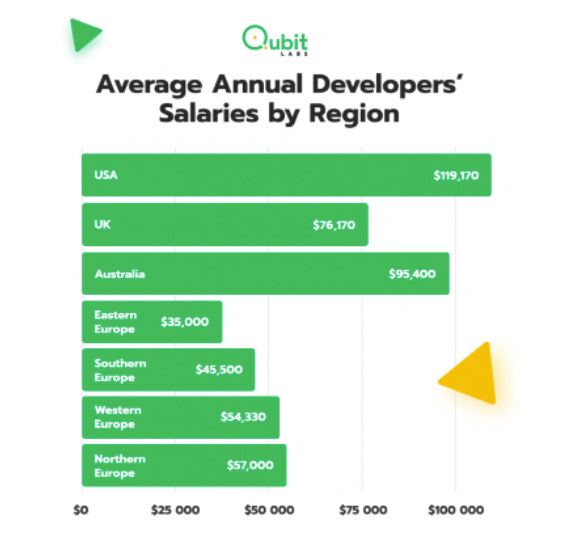Issue #66: Global Market Value
In response to last week’s issue, @HelloShreyas commented that another important way Web 3 was contributing to a more even distribution of wealth was how the industry compensates talent, regardless of location.
It’s a fact that on average, resources in places like India, Eastern Europe or Southeast Asia have historically been paid a lower salary or hourly rate than resources in the US, Western Europe or Australia. The justification for the disparity is an exercise in labor economics, but it boils down to productivity (a more complicated calculation than just how hard someone works), supply and demand and the cost of living.
It’s the same inside the US too. A role based in San Francisco or New York City will command a higher salary than the same role based in New Orleans or Charlotte. The costs of living are different between “Tier 1” and “Tier 2” cities, and the competition for talent in those areas differs as well.
Interestingly, because of crypto’s global markets and “remote-first” culture, the current trend is to compensate talent based purely on experience and ability without factoring in their location.
In other words, talent in Web 3 has a global market value instead of a regional market value.
When you say it, it feels obvious, especially in a world that has undergone hyper globalization during the last 20 years. But this goes against the pre-pandemic status quo.
There are a lot of things Web 3 should be proud of, and a global market value for talent is one of them.
Let’s zoom in…
The Status Quo
Skills and experience in the job market have historically had a regional value. When jobs were tied to an office location, compensation levels were a function of the labor dynamics in that locale.
Companies were willing to pay X for a certain skillset and experience level in a particular city. In higher cost of living areas (a la San Francisco and New York), compensation is generally higher because the labor living in that market needs more money to live there.
Competition is also a factor. If there are dozens of companies vying for the same pool of talent, compensation levels will be pushed higher until the talent pool grows enough to meet demand.
Here is a chart showing average software developer salaries by region. The average salary in the US is 240% higher than the average salary in Eastern Europe.
The trend of outsourcing / off-shoring labor by large companies has perpetuated the idea of “regional value”.
Global Market Value
Web 3’s “remote first” culture and global nature means companies can hire from anywhere, and talent can work from anywhere. This has created a new global talent pool, and talent has a global market value.
Our team at Forta is a poster child of the Web 3 workforce. We are a team of roughly 20, with people in at least 7 countries. Several of us (including me) are nomadic, constantly moving to different cities/countries. We’re an HR nightmare.
The Forta Foundation has a legal domicile, but the project has no actual headquarters. The country most represented on the team is actually Argentina.
When we are hiring for a new position, we want to hire the best talent wherever they are in the world. Our talent pool is global. If we found a top-notch developer or marketing lead living in Antartica, we would hire him/her as long as they had reliable Internet access.
A global talent pool creates a unique competitive dynamic though. It means we are competing for talent with companies and projects located all over the world…big and small, Web 2 and Web 3, centralized and decentralized.
At least in Web 3, amongst similarly situated projects, this gives talent a global market value. An all-start talent living outside the US can command US rates (the highest average in the world) because there’s another Web 3 project willing to pay them if you won’t.
I’ve also heard it’s also a lot easier administratively to treat everyone the same. Web 3 teams are small. If they have a decentralization roadmap, most of them will stay small. They don’t want or need to employ full-time HR teams to manage the nuances of a global workforce.
Another variable impacting compensation levels across Web 3 is supply and demand. The number of Web 3 companies that have formed and raised money over the last year has exploded. Many of these teams are flush with cash and looking for experienced talent. There is a surplus of demand and a shortage of experienced talent.
Translation - it’s a talent friendly market, and it’s been this way for a few years. This motivates projects to cast the widest net possible for talent (aka global talent pool) resulting in a global market value for that talent.
Parting Thoughts
Interestingly, forward-thinking Web 2 companies are trending the same direction. I saw a tweet two weeks ago from Brian Chesky, CEO of Airbnb, announcing the company’s new remote work policy.

Global talent pool = global market value. As an employer, if you want to stay competitive, you need to be flexible with location, and competitive with compensation regardless of the candidate’s location.
The next question is what the long term effects of this trend are? Do average salaries, especially for technical talent, go up across the board? Does supply and demand find a global equilibrium eventually?
Thanks for reading,
Andy
—
Not a subscriber? Sign up below to receive a new issue of 30,000 Feet every Sunday.




